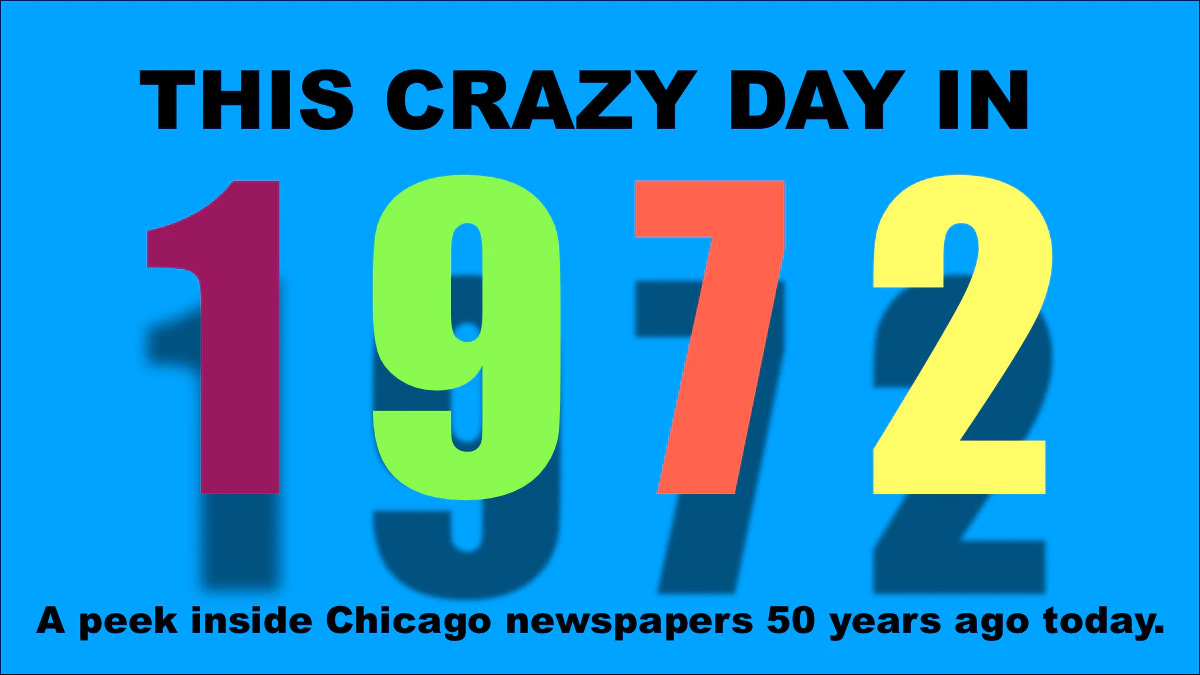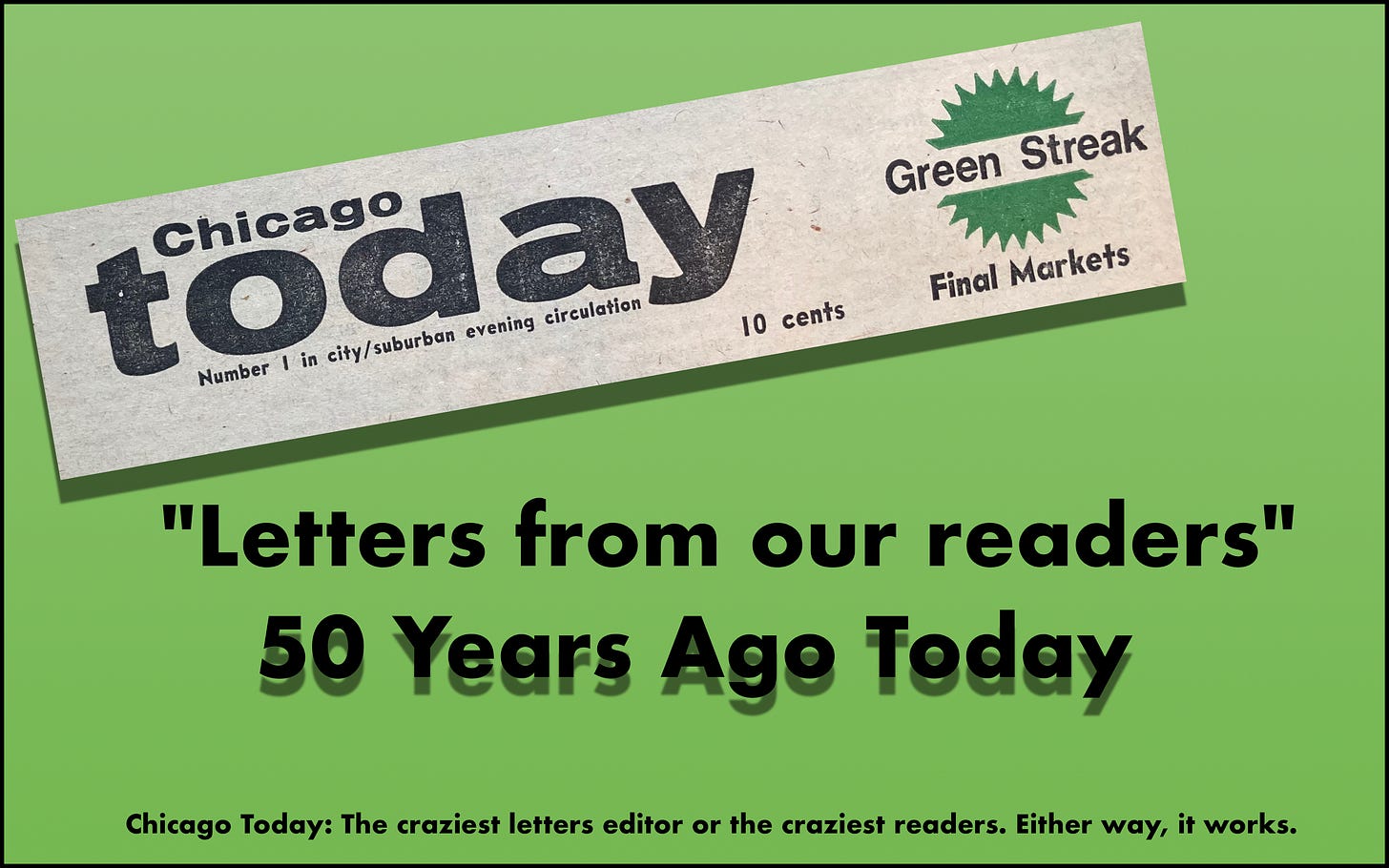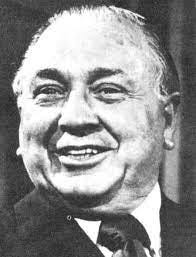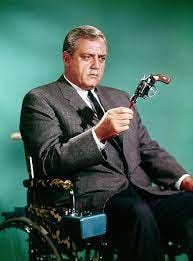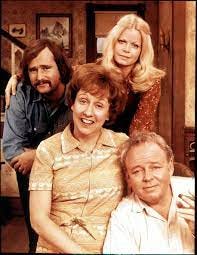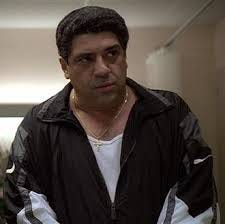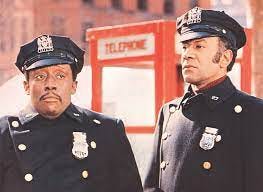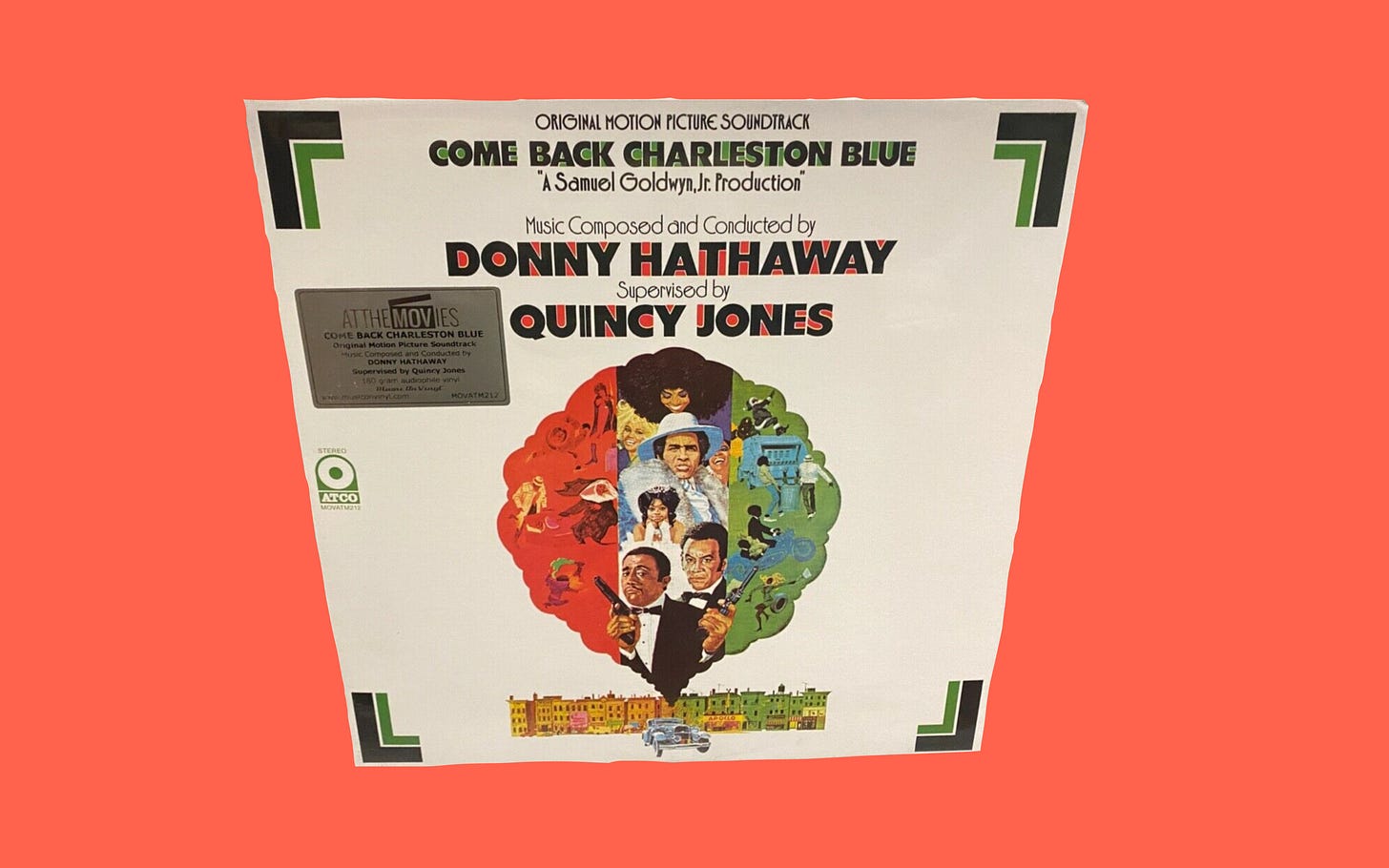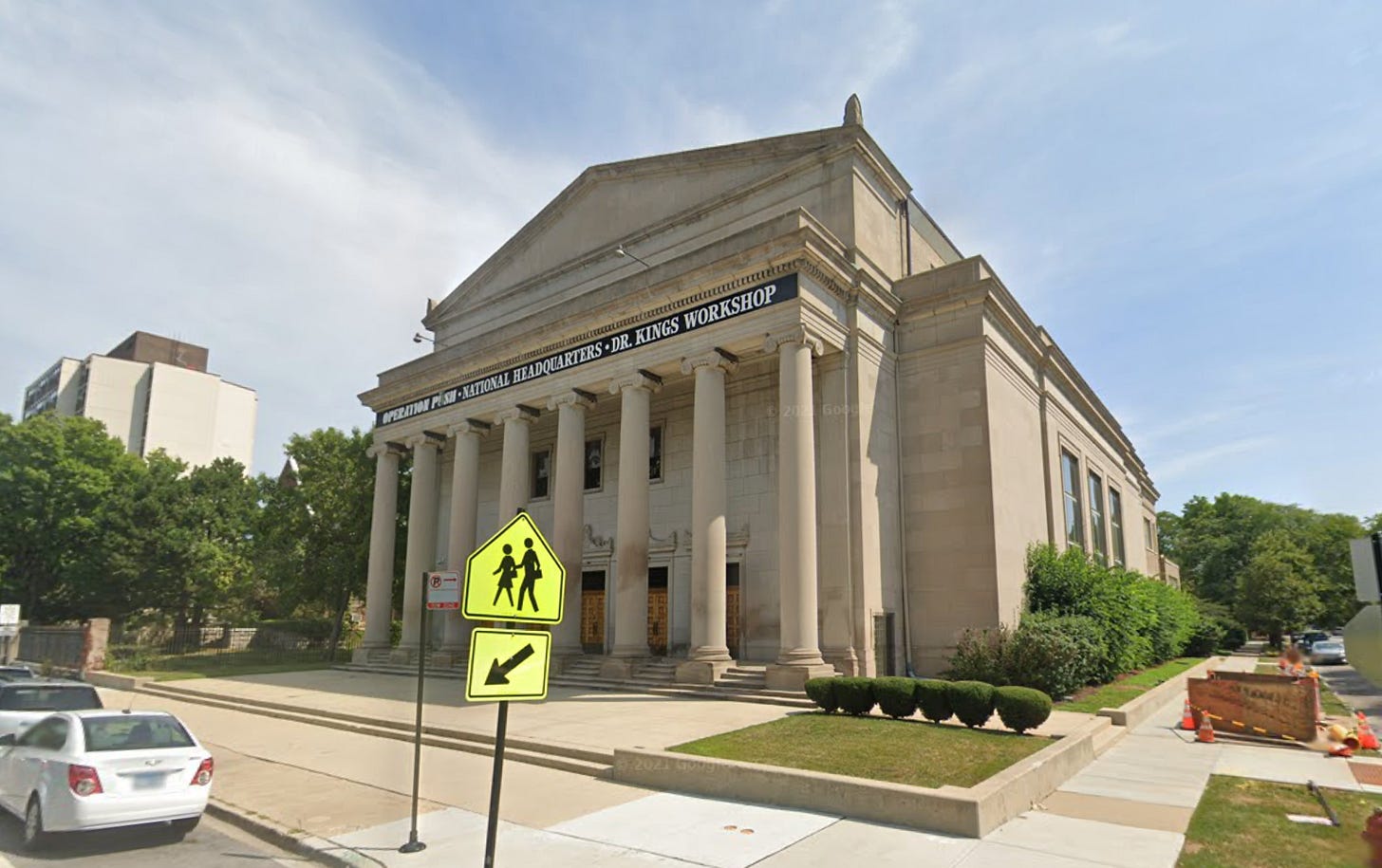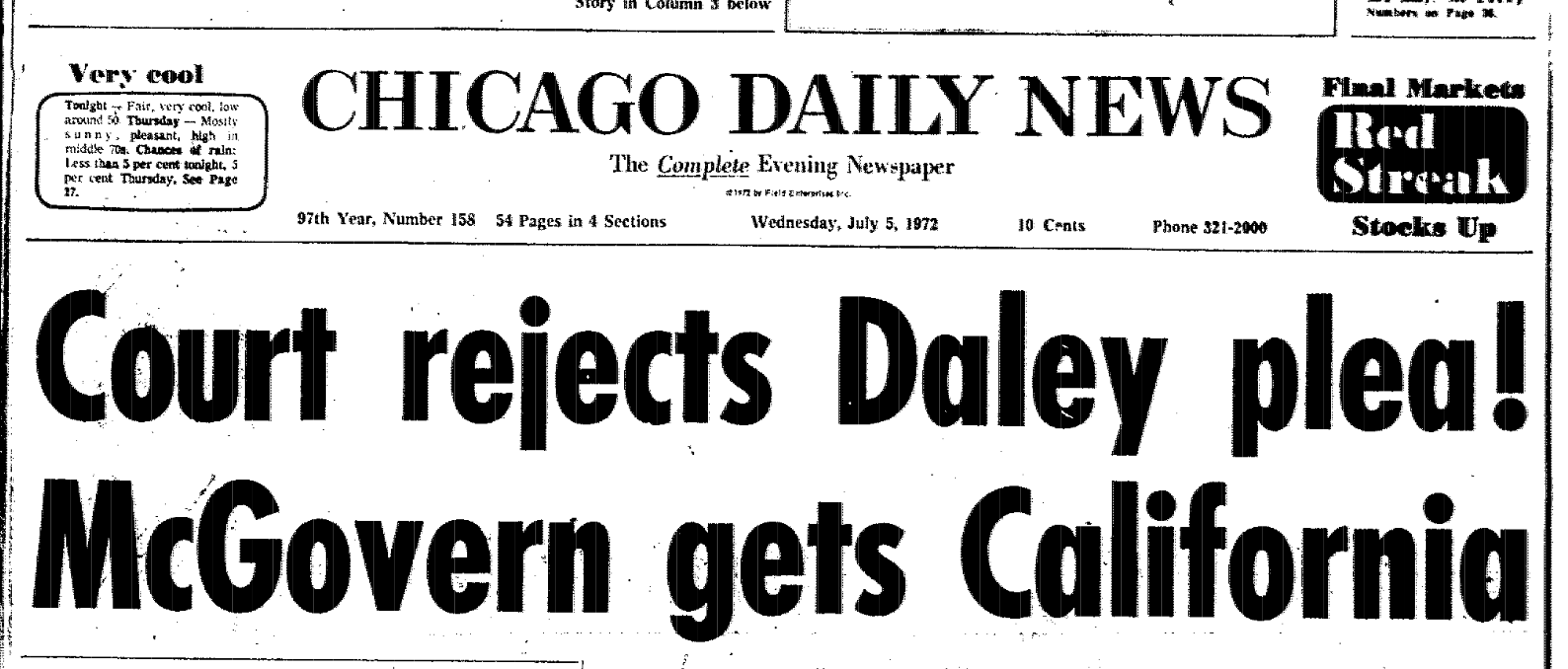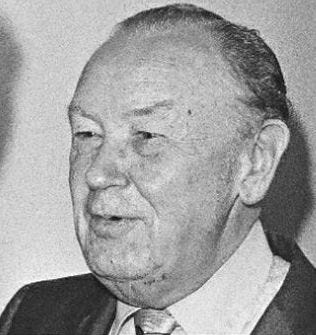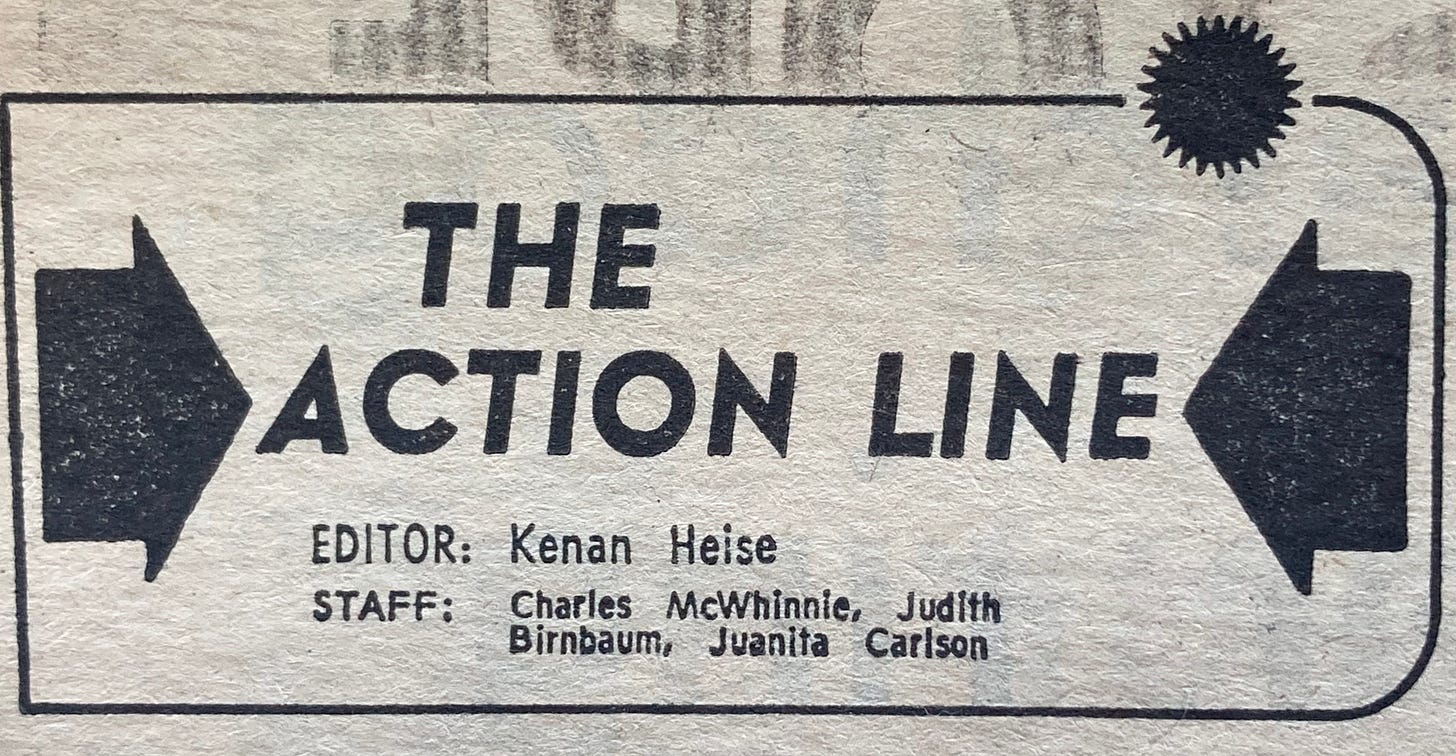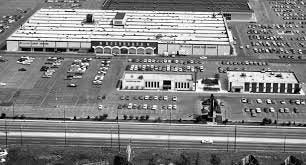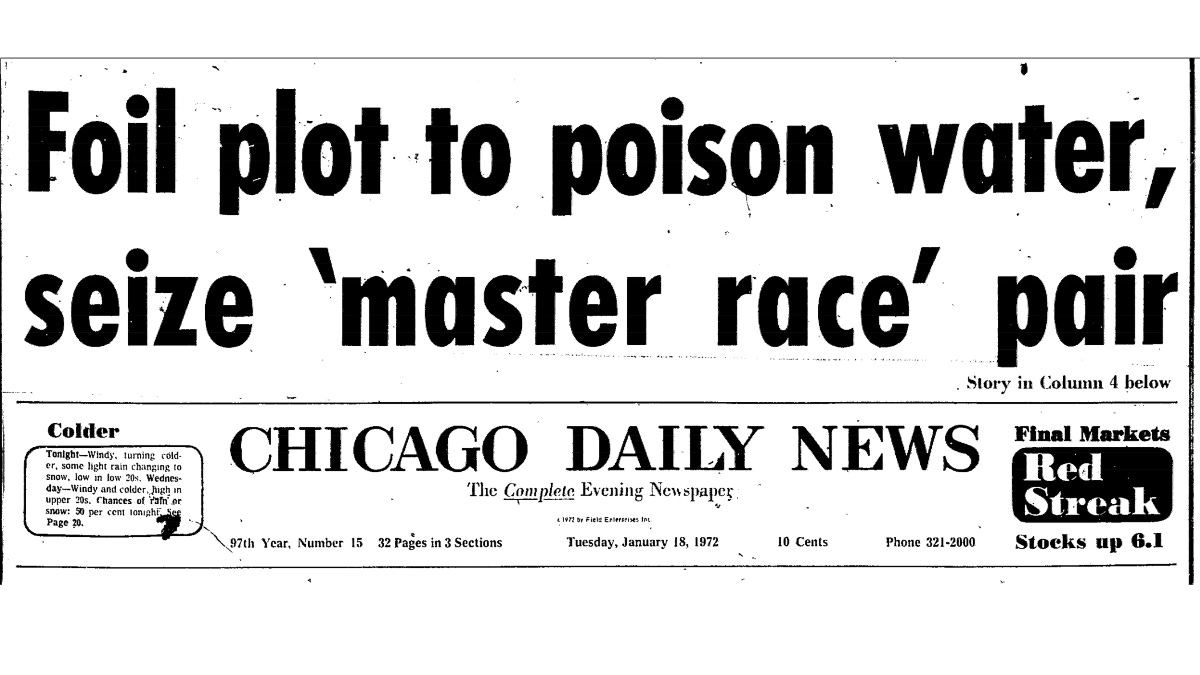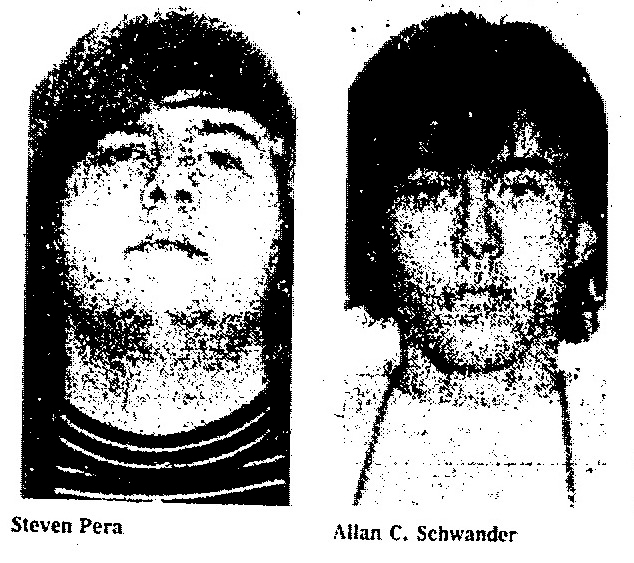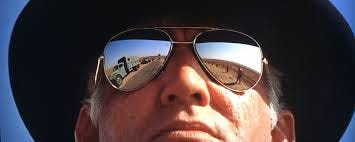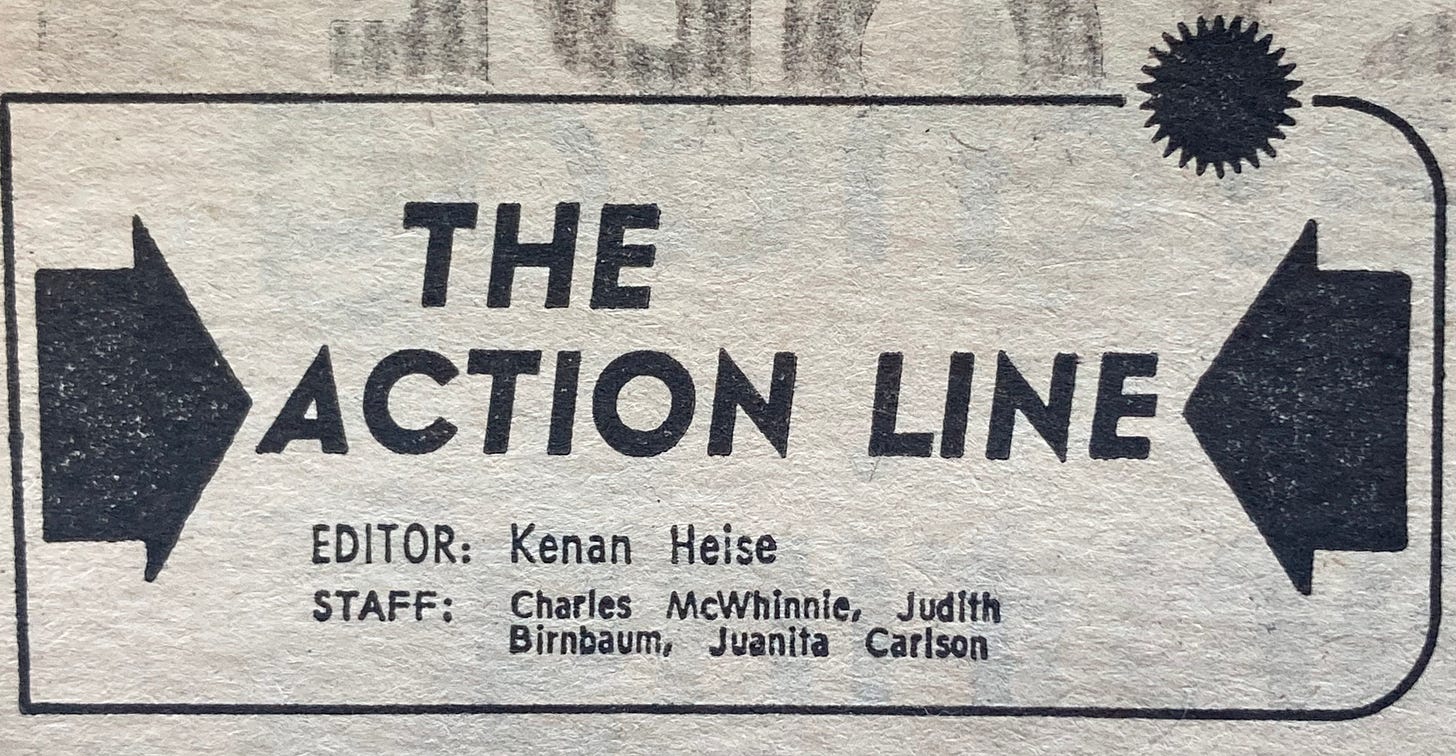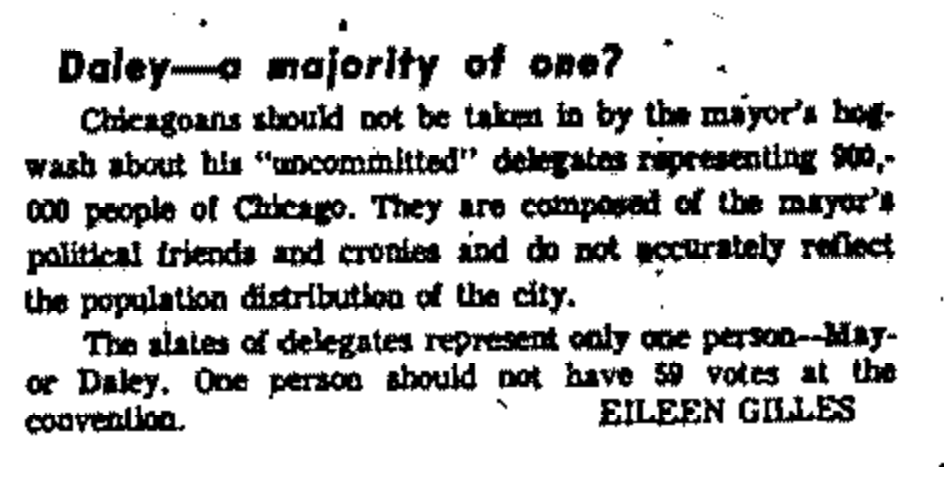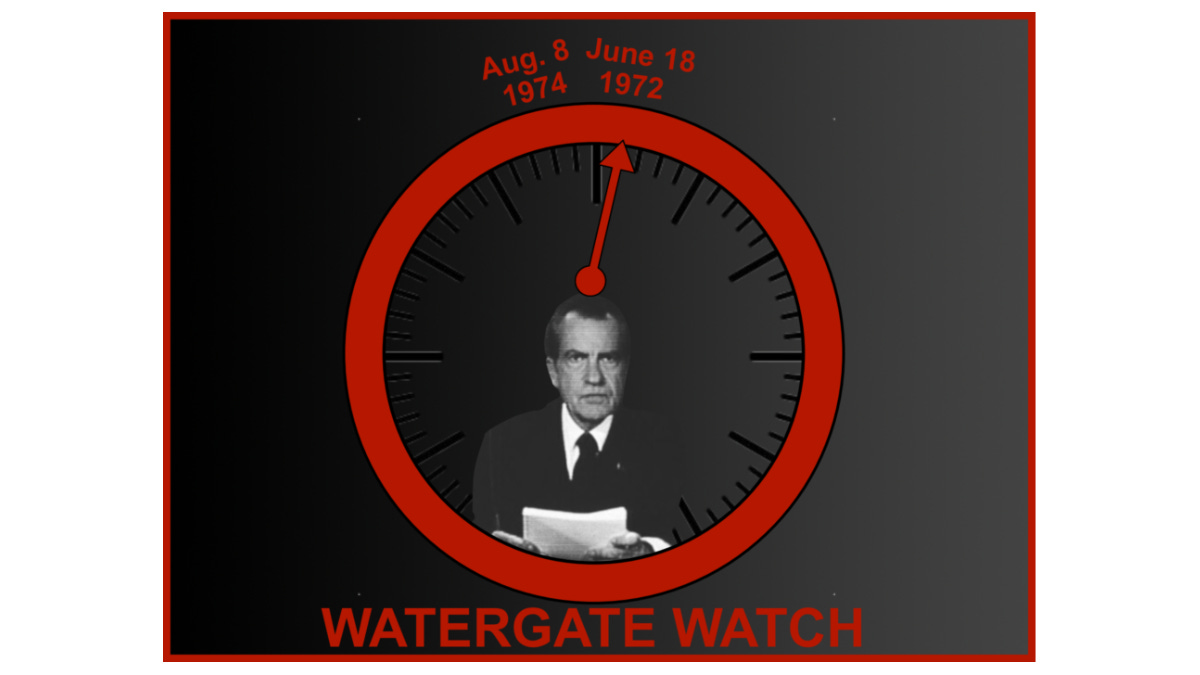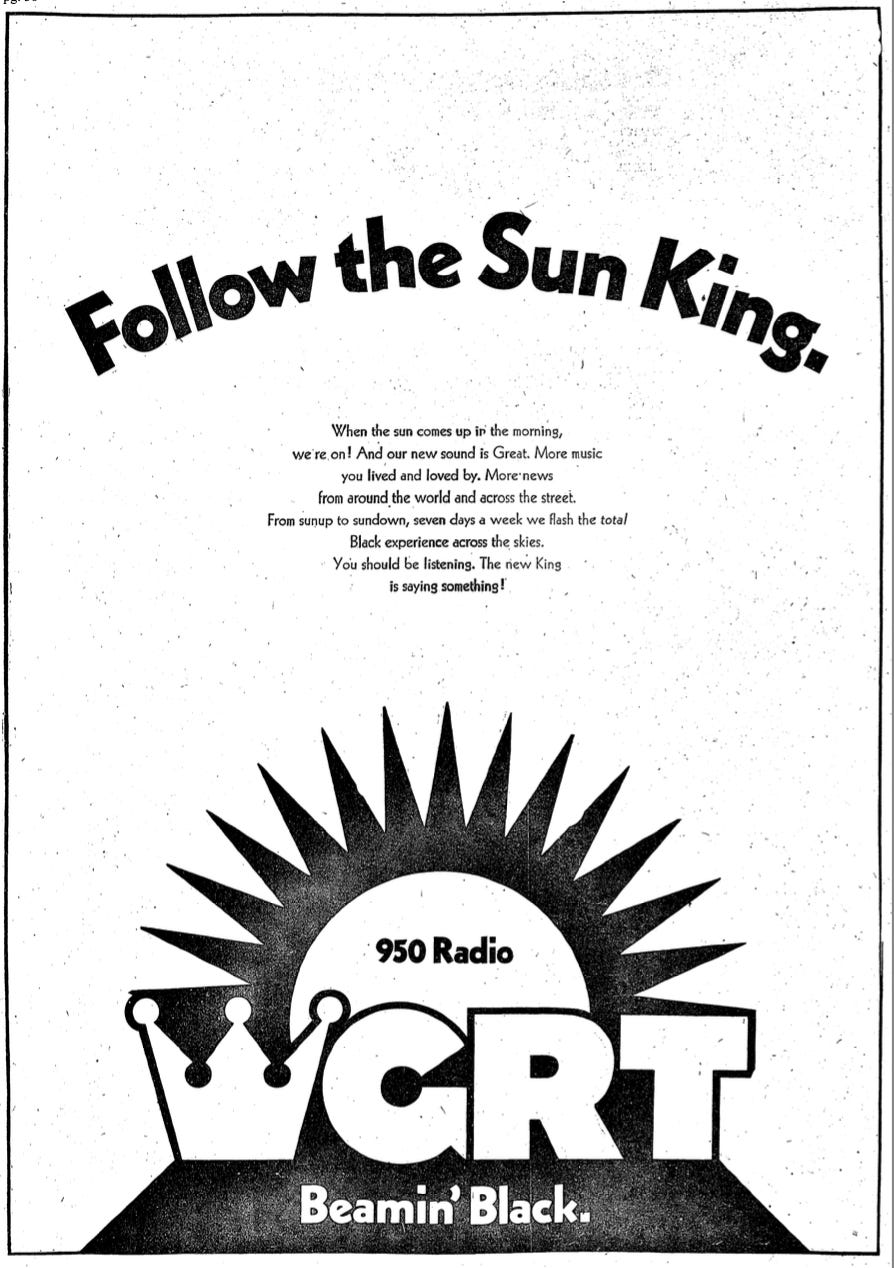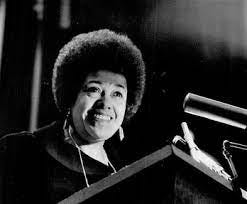THIS CRAZY DAY IN 1972: Getting ready for the party
Weekly Compilation July 3-9, 1972
To access all website contents, click HERE.
Why do we run this separate item peeking into newspapers from 1972? Because 1972 is part of the ancient times when everybody read a paper. Everybody, everybody, everybody. Even kids. So Steve Bertolucci, the 10-year-old hero of the novel serialized at this Substack, read the paper too—sometimes just to have something to do. These are some of the stories he read. Follow THIS CRAZY DAY on Twitter, @RoselandChi1972.
July 3, 1972
Mr. Biety got a birdie on this one—his letter also appears in the July 6 Daily News, where the letters editor apparently doesn’t read the competition.
July 3, 1972
Chicago Today
by Jeff Lyon
The papers reported on July 1—after months of wrangling—that the Democratic National Convention’s Credentials Committee had dumped the 59 elected Cook County delegates to the convention, including Mayor Daley, in favor of an alternate slate of delegates from independent Democratic challengers led by Ald. Bill Singer and Rev. Jesse Jackson.
Mayor Daley lost by three votes.
It’s not really over—the case is back bouncing around in the courts, and if the courts don’t settle it, that means at the convention…
But that will happen when the convention opens in Miami next weekend. It will be a wild ride, day to day and newspaper story to newspaper story.
Today’s Jeff Lyon picks up with Singer after he returns to Chicago from lobbying the Credentials Committee in Washington.
“Say you lived in Provo, Utah. You probably would have heard of Mayor Daley, the man who supposedly brings it all home for the Democratic Party each election,” writes Lyon.
“It is a pretty good bet you never heard of William Singer, tho. He is a lawyer, an independent Chicago alderman [43d], and what he usually brings home is a carton of milk from the supermarket.
“Friday, the stubby alderman brought home the biggest thing you ever saw in a brown paper bag. Daley himself, and his organization, all wrapped up nicely and tightly, possibly ready for freezing.”
Lyon talks with Ald. Singer as he happily gets out of suits and back into “a sweater and tennis shoes, tucking in his 4-year-old daughter” and so on.
“You know the Daley people, they just didn’t understand what we were trying to do,” Singer tells Lyon. “Honestly, after the credentials people voted and the mayor was out, one of Daley’s men came up to me and chewed me out. But what he said was, ‘How do you expect me to go back to Chicago and tell my organization about this after they delivered all those votes for us? What are you trying to do? Weaken the party?’”
“They don’t understand delivering votes was what the party delegate reform issue was all about. You aren’t supposed to deliver votes like that. It isn’t democratic. This was a matter of principle, among other things, not a vendetta against the mayor or the party.”
“Singer said he was baffled why Daley has refused to compromise and why the mayor considers his delegate control so important when he has bent on other issues.”
July 3, 1972
Chicago Sun-Times
By William Granger and Judy Nicol
“No compromise with Mayor Daley was the word Sunday night from the Rev. Jesse L. Jackson after a meeting with Ald. William S. Singer (43d).”
Singer told a press conference at the airport after arriving home from Washington, “It is not within our discretion to compromise” and “We are the delegates now.”
“Mr. Jackson verbally widened the breach between the Singer-Jackson group and the Daleyites by accusing ‘Daley forces’ of being behind a fire set in the Operation PUSH headquarters less than 12 hours after the Credentials Committee kicked out the Daley delegates.
“‘I do not separate the vote on Friday from that arson attempt at all,’ said Mr. Jackson. ‘It is similar to the violence of the Daley forces when they disrupted our (delegate) caucuses last week. I believe Daley forces were behind that arson and it’s significant that our building is in the 4th Ward and that’s (Daley loyalist Ald.) Claude Holman’s ward.”
“After a fire in [new PUSH headquarters, the K.A. M. Temple at 930 E. 50th], firemen found a can half-filled with gasoline near the fire scene.”
Note: We haven’t covered the fire bombing of the PUSH headquarters because coverage is bizarrely small and later becomes nonexistent, even in the Defender.
The first mention of the fire bombing comes in the Defender on July 3—not in the headline, but tacked onto the end of an article about Rev. Jesse Jackson’s latest statements on the delegate challenge:
“The temple had been fire bombed several hours before the group [of PUSH members] marched from its former meeting place at Shiloh Baptist church, 4840 S. Dorchester [on July 1], in what was considered an act of retaliation against Mr. Jackson for his political involvement.
“Several windows in the building were broken and the foyer was damaged by the fire. Nord Lawson, the temple’s caretaker, told reporters he knew nothing of the fire. Fire Chief Arthur Huntington said firemen found a two and a half gallon tin can just inside a shattered ground-level window. The can, found at the northwest corner of the building, was believed half-filled with gasoline.”
As far as I can see in the Defender digital archives, the firebombing was mentioned only one more time, on July 12, when Thomas N. Todd, PUSH executive vice president, held a press conference at Dr. King’s Workshop, 7941 S. Halsted, demanding that Chicago restore Rev. Jesse Jackson’s police protection due to death threats; the July 1 fire at KAM Temple; a June fire bombing at Dr. King’s Workshop that I can find no news reports on at all anywhere; and a new burglary incident at the Workshop in which “six typewriters, several radios and tape recorders” and $200 were taken.
That July 12 press conference was also covered in the Tribune—the first and last mention in that paper of any firebombing or burglary at either PUSH location. So it’s unclear how the investigations into any of those incidents turned out, and whether they were definitely linked to the Democratic Convention delegate challenge.
July 3, 1972
Chicago Today: Bruce Vilanch TV Report
“There is so much happening in Hollywood these days, you just can’t keep track,” writes our favorite TV critic. “Everywhere you look people are being shot, stabbed, gored, garroted, disemboweled and otherwise made sport with.
“The people wreaking all this havoc are policemen, private detectives, federal agents, secret service spies, insurance investigators and other servants of the public. Naturally, they are only getting away with all this stuff on TV. It would never happen in real life.
“Or would it?” Bruce wonders.
Bruce says Quinn Martin, the man behind “some of the most successfully violent dramas on American television,” insists that his shows are just real life.
“Or is it?” Bruce wonders again.
Bruce writes that “According to New York City police, three of every four burglars in New York defecate at the scene of the burglary. Not in the bathroom, but at the vault, in the bedroom, or in the fur closets. They do this mostly because they are terrified, and when terrified, humans tend to lose control of some of their voluntary muscle reactions, including the bowels.”
“Now how many times have you seen that on Ironside?”
Bruce is so right.
“All in the Family,” still a new show in our 1972 timeline, was the first to even use a toilet flush sound effect.
But in 2022, we all probably remember when Christopher defecated on himself in Season One of “The Sopranos,” after Uncle Junior had some guys mock execute him. In Season Two, Christopher takes two young guys under his wing, and when he teaches them how to break into a safe, one of them drops a load nearby—as Christopher tells them that a young Big Pussy Bonpensiero once left a pile so large at a crime scene that the cops thought a bear had been there.
Bruce could never have foreseen such onscreen goings-on in 1972. Today, he reports that NBC and ABC are about to premiere so many violent shows in the fall that “the advertising salesmen might as well call the 7 to 10 p.m. time slots ‘network crime time.’” [For Younger Readers: It’s a pun. This time period used to be known as “prime time.”]
The new shows include George Peppard’s “Banacek” and—
“THE DELPHI BUREAU (ABC) - Laurence Luckinbill as a fellow with a photographic memory and a penthouse apartment at Washington’s Water Gate. He is in the service of his government. I forget what he does. So does he.”
Prescient!
And:
“PROBE (NBC) - An eighties dick [old-timey word for “private investigator”], doing all those everyday things in that wonderful futuristic manner.” Which is now the retro backdrop for “Stranger Things.”
Bruce’s sign-off:
“Oh, the routine is killing me.”
July 3, 1972
Chicago Sun-Times
(UPI)
By Carl Bernstein and Jim Mann
Washington Post Special
In a kind of double feature, the Sun-Times jams together two short updates on that weird little burglary thing that happened a little over two weeks ago in Washington.
“Democratic National Committee (DNC) Chairman Lawrence O’Brien “again urged President Nixon on Sunday to appoint a special prosecutor to investigate the break-in” of DNC’s offices at the Watergate office complex.
O’Brien sent a telegram to Nixon reading: “It is your decision whether this unparalleled case lands in the political arena or is treated in a cold, impartial and determined manner that will insure that the constitutional rights of all Americans are protected.”
He makes that point because Nixon hasn’t responded to O’Brien’s first request for a special prosecutor. As the telegram notes, “I am informed that you have referred the matter to the Committee for the Re-election of the President as a political matter.”
Per Bernstein and Mann, 150 FBI agents are looking for Howard E. Hunt, “the former White House consultant whose name has been inked to the suspects charged in the alleged attempt to bug the headquarters of the Democratic National Committee.”
A federal grand jury is investigating the bugging and burglary, “according to federal sources close to the investigation.”
Hunt reportedly refused to cooperate with FBI agents when they questioned him ten days ago. His name was found in the personal phonebooks of the two of the Watergate burglars. [For Younger Readers: Before smart phones, adults had little notebooks, “phone books,” in which they wrote down all their contact info—even burglars.]
Hunt worked for the CIA 1949-1970, and now works as a “$100-a-day White House consultant on the recommendation of Charles W. Colson, a behind-the-scenes political strategist who is special counsel to President Nixon.”
July 4, 1972
Chicago Sun-Times
This will come in handy if you have access to a time machine, or get stuck in the Twilight Zone. You’re welcome.
July 4, 1972
Chicago Tribune
July 4, 1972
Chicago Sun-Times
“Charleston Blue set out one morning in 1932 to do away with a gangster named Dutch Schultz,” writes Roger Ebert, and let’s remember that in three years Ebert will become the first film critic ever to win the Pulitzer Prize.
“He planned to cut the Dutchman’s throat with one of the elegant razors that were his trademark: blue steel, ivory handle made to order in Charleston. But apparently something went wrong, maybe because a razor is no match for a tommygun, and Charleston Blue dropped out of sight and became a Harlem legend.
“That’s the way ‘Come Back, Charleston Blue’ tells it, anyway, and the movie begins in 1972 when the legend has apparently returned to Earth. His mission this time is similar to his original one: to drive the white mob out of Harlem and take over the drug traffic for himself. This is plainly a case made to order for Gravedigger Jones and Coffin Ed Johnson, who are simultaneously the most famous and infamous detectives in Harlem.”
Ebert notes that Gravedigger and Coffin Ed appeared first a few years ago in “Cotton Comes to Harlem,” one of the first of the current crop of all-Black productions. (Both movies, of course, are based on the books by Chester Himes.) That movie differs from others of the genre, though, writes Ebert, “because of a certain light-heartedness and a willingness to go for comedy rather than violent action.”
“Charleston Blue” keeps that vibe, and “gives us another look at Godfrey Cambridge and Raymond St. Jacques as the most laconic team of detectives since ‘Dragnet.’”
Ebert finds it refreshing that the film doesn’t try to make supermen out of its heroes, which also makes them more interesting: “By the same token, we remember the eccentric and bizarre character actors in James Bond movies, and sometimes see Bond himself as simply the link that brings them together.”
Gravedigger and Coffin Ed are neutral, writes Ebert, in the “battle between the black and white drug-runners….The movie seems to be neutral, too. Joe Paynter, the black mobster, wants to drive the Mafia forever out of Harlem, but mainly because he wants the drug action for himself. This is not exactly a noble position, and the movie regards it with a nice dry cynicism that seems altogether appropriate.”
July 4, 1972
Chicago Sun-Times: Kup’s Column
by Irv Kupcinet
Kup is a 20th Century Chicago journalism giant, whose column started in the Chicago Sun. Kup’s typical column is “Walter Winchell-style” column, with little bits of all kinds of news, from politics to society and celebrities, often separated by “…..”. Today’s column is unusual for reprinting this short patriotic essay—and we’ll come back to that in a moment.
The Walter Winchell-style column will sound like a trivial gossip column to modern readers, but Kup was not really a gossip columnist. He covered everything. In terms of readership, Kup’s type of column was as important to early and mid-20th century newspapers as a serious political columnist.
In Chicago, particularly before Mike Royko, Kup was probably the most well-known columnist there was—arguably even the most important. After Royko, Kup finally had a colleague as well known as he was.
When people said Kup knew everybody, that was not an exaggeration.
And Kup is the one with the statue.
We’ll take a longer look at Kup when time allows. Back to Kup’s patriotic essay by Otto Whitaker.
Kup isn’t just being an annoying old fogey here, though this column would have been annoying to young people in 1972 too. While it may seem like all of American history up until yesterday was one long replay of everybody singing “It’s a Grand Old Flag” from coast-to-coast, in fact 1972 America was in a deep funk, questioning everything about itself, pretty much as we are in 2022. And that was before Watergate revved up. Which figures, since the Civil Rights movement is not yet something referred to in a historical sense, and the Vietnam War is still raging. In our timeline, the Daily News just finished running a series called “The Spirit of America,” which tried to figure out why everybody is so depressed.
Older Americans in 1972, a gigantic proportion of whom were immigrants and their children who escaped totalitarian regimes and extreme poverty, would find Kup’s column today quite stirring. But it will sound naive to most modern ears, especially if you ever actually read about the Maine. Or the Alamo.
A few excerpts:
“I was born July 4, 1776, and the Declaration of Independence is my birth certificate. The bloodlines of the world run in my veins, because I offered freedom to the oppressed. I am many things and many people. I am the Nation. I am 200 million living souls—and the ghost of millions who have lived and died for me. I am Nathan Hale and Paul Revere. I stood at Lexington and fired the shot heard round the world….
“I remember the Alamo, the Maine and Pearl Harbor. When freedom called I answered and stayed until it was over, over there….
“….I am the Brooklyn Bridge, the wheat fields of Kansas and the granite hills of Vermont….I am sleepy villages and cities that never sleep….I am Babe Ruth and the World Series….I am a ballot dropped into a box, the roar of a crowd in a stadium and the voice of a choir in a cathedral. I am an editorial in a newspaper and a letter to a congressman….
“I was conceived in freedom and, God willing, in freedom I will spend the rest of my days. May I possess always the integrity, the courage and the strength to keep myself unshackled, to remain a citadel of freedom and a beacon of hope to the world. This is my wish, my goal, my prayer on July 4, 1972—196 years after I was born.”
Kup finishes the column with his typical fare, concluding:
“….July 4 treats: The American Legion fireworks show at Soldier Field; Dick Gregory headlining the PROUD (prisoner rehabilitation) observance at United Church in Hyde Park, and the Wellington-Oakdale Old Glory Marching. Society parade….And for your July 4 picnic: It’s easy to barbecue meat these days—first you light a fire under your checkbook!”
July 5, 1972
Chicago Daily Defender
by Robert McClory
“A fire department investigation for possible arson was underway Tuesday after a blaze of mysterious origin prevented a mass meeting of the Coalition for United Community Action at a Southside church Sunday afternoon.
“The blaze, at the Mount Sinai Baptist Church, 1235 W. 59th, followed by one day a firebombing of the former K.A.M. Jewish Temple, 920 E. 50th, the newly purchased headquarters of Operation PUSH.
A Coalition rally at Mount Sinai had to be postponed, though the church was only slightly damaged. A garage and station wagon parked next to it were destroyed. Fire Chief Stan Szablewski said there was no immediate evidence of arson, but an investigation is pending.
“The Coalition for the past two weeks has been marching on construction sites in black neighborhoods, demanding 50 percent black representation on each job. The most frequent target has been the Peoples Gas, Light, and Coke Company, and an attempt last Wednesday to shut down one of its sites, at 95th and Yale, resulted in the arrest of four Coalition members, including Mr. Turner.”
From the Defender’s June 29th edition, also by Robert McClory: Peoples Gas was replacing gas pipes on 95th when the Coalition tried to shut down the job with 100 members, because while there were some Black workers, they didn’t make up 50% of the crew.
“The company insists that the 50 per cent demand is unrealistic,” wrote McClory. “Carl Latimer, executive director of the Coalition, said [Peoples Gas] has agreed to hire more minority workers only through employee turnover and attrition, but not through a active recruitment programs.” Peoples Gas disputed that, telling McClory “its current recruitment activities for minority employees are among the best of any Affirmative Action employer in the country.”
The Coalition had shut down the Peoples Gas 95th Street project twice last week, but on the third try on June 28, Peoples Gas called police.
“The Coalition marchers were ordered to stay on the sidewalk and not to interfere with the crews.” Four men were arrested, while the rest stayed and watched the crew work under police protection.
The Coalition’s Rev. Turner said witnesses saw several youths fleeing Mt. Sinai after the fire. “I am absolutely convinced someone hired some kids to start those fires, just to disrupt our activities,” he told McClory.
THIS WEEK, CHECK OUT MIKE’S TAKES ON THE SINGER-JACKSON DELEGATES TO THE DEMOCRATIC NATIONAL CONVENTION!
If you’re a regular THIS CRAZY DAY reader, you’ll probably want to follow Mike Royko 50 Years Ago Today too.
July 5, 1972
by Robert Greenberg
“The U.S. Court of Appeals Wednesday refused to reinstate Chicago Mayor Richard J. Daley and 58 other delegates to the Democratic National Convention.
“At the same time, the court declared ‘null and void’ a ruling by the convention’s credentials committee taking 153 California delegates from Sen. George McGovern.”
By Jay McMullen and Lu Palmer
Ald. Tom Keane, Mayor Daley’s floor leader and chairman of the powerful Finance Committee, “predicted Wednesday that Daley’s Cook County organization would take an ‘inactive’ role in the presidential and gubernatorial races in November.”
“Keane…made the prediction after hearing that a federal appeals court in Washington had refused to reverse the action of the Democratic National Convention’s credentials committee, which last Friday voted to oust 59 Daley delegates from Chicago.”
Sen. George McGovern’s people on the credentials committee voted against Daley, so the battle is now also Daley vs. McGovern.
“‘If Sen. (George) McGovern is nominated, apparently his presidential campaign will be run locally by Ald. (William) Singer (43d) and (the Rev.) Jesse Jackson,’ said Keane.”
Meanwhile, “Efforts to head off that kind of sub-standard organization performance” are underway, with McGovern’s people working on a compromise. Gary Hart, a campaign advisor, is in Chicago talking to Rev. Jesse Jackson about it.
“In Chicago, Mr. Jackson revealed that 14 of the 21 blacks on the ‘challenge’ delegation had caucused to discuss a compromise.
“He said the group decided that a ‘synthesis’ of the Daley delegation and the challenger delegation ‘would be in the best interests’ of both the anti-Daley forces and the national Democratic Party.
“‘The fatal mistake made by the old guard of the party in 1968 was that it thought it could do without the new guard,’ said Mr. Jackson. ‘And the new guard cannot make the same mistake of thinking it can do without the old guard in 1972.’
“However, Singer—co-leader of the challengers—has appeared no more willing to discuss compromise than has Daley.’”
July 5, 1972
Chicago Today
Charles Smith of Buffalo, 23, stabbed his ex-wife, her mother, and an unidentified man before driving to the Buffalo airport with his three-year-old daughter, where he ran onboard an empty American Airlines 707 jet parked at a terminal gate. Martin held a big knife and threatened to kill his daughter.
“I want a pilot, I want a God damn pilot,” Martin shouted at police and FBI agents, who surrounded the plane.
Bu he surrendered after a little over an hour of talking with a minister and “a woman acquaintance.” “A witness said the man still held the youngster in his arms as he walked down the ramp of the aircraft.”
“During the conversation and unknown to Smith, two FBI agents crawled into the cockpit of the plane and were closing in on him when he decided to give up.”
Photo from the Chicago Daily News:
July 5, 1972
Chicago Today: Editorial
Earlier this year, U.S. Attorney General John Mitchell quit his position to head President Nixon’s Committee to Re-Elect the President (CRP, aka CREEP). A few days ago, Mitchell quit his CRP/CREEP position, after wife Martha Mitchell told UPI reporter Helen Thomas that she would leave her husband if he didn’t get out of politics.
But there’s a little more to John Mitchell leaving the Nixon campaign. Martha Mitchell told UPI reporter Helen Thomas about her ultimatum just before somebody cut short their conversation by pulling the phone out of the wall of Mitchell’s hotel room in Newport Beach, California. Thomas could tell somebody had forcibly ended the call. She reported what sounded like a kidnapping on June 23—along with John Mitchell’s assurances that Martha was just unhappy in politics.
On June 26, the New York Post’s Marcia Kramer found Martha Mitchell relocated from California to the Westchester Country Club. Martha Mitchell told Kramer she’d been thrown on a bed by several guards, and they “stuck a needle in my behind.” AP distributed this updated story nationally. Newspapers used the word “needle” to create headline puns, such as Chicago Today’s “Martha can’t take needling.”
Now, Chicago Today’s editorial board has decided that this all sounds like a love story.
July 6, 1972
Oh boy oh boy oh boy, Chicago Today announces who it’s sending to cover the upcoming 1972 Democratic National Convention—and guess who they included?
July 6, 1972
Chicago Today
Ford City was the first mall many South Side Chicagoans ever knew. It opened in 1965 at 76th and Cicero, carved out of old Defense Department plants built for World War II war production. Ford took over some of those buildings for car production for a while after the war, explaining the rather unusual mall name.
Ford City lives on, but Vanished Chicagoland discusses Ford City in podcast Episode 140, and Vanished Chicagoland’s Pete Kastanes specifically discusses the Ford City Bowling Center in a blog post:
“The one thing that stood out in my mind was smoking there,” writes Pete. “The ashtrays were constantly overflowing with cigarette butts and gum wrappers. The distinct smell of the cigarette smoke lingered in that place for countless hours.”
July 6, 1972
No byline
“West Side activist Russ Meek charged Wednesday that Mayor Richard J. Daley and Police Superintendent James B. Conlisk Jr. are apparently more concerned about protecting the police department than solving the murders of seven black businessmen, whose execution-style slayings have been linked to five black policemen.
“‘Who is covering up for whom? How far up the ladder does the guilt reach? Mayor Daley has said little or nothing and this can be expected as he derives his power from the use of the police force,” Meek declared.
…. “He also warned that police are using the stop and frisk law to continue to ‘brutalize and murder blacks.’
“ ‘The grave danger of the moment is the failure of any organized effort to combat the rising rate of police killings of blacks in this city,’ Meek charged. An example, he said is the ‘brutal and unnecessary’ killing of Edward Doleberry, who was killed by 3 policemen on June 26, in the 4200 block of West Madison st.”
Police were called after Doleberry stabbed his brother, who died.
“‘Anytime three well-trained police can’t handle one man with a knife, they are either cold blooded murders or they don’t belong on the police force, or the Boy Scouts for that matter.”
There’s no other news this week in the “hit squad” case, in which four to five Black cops are suspected of killing up to seven Black men as part of narcotics trafficking—news which leaked out of an FBI investigation even though there have been no arrest or indictments. On June 26, the papers reported that one suspected cop, Stanley Robinson, vanished in a possible kidnapping. (See here for more on June 20, 21, 22 and 25.)
Don’t miss the Chicago History Rabbit Hole in the Weekend Edition of this week’s Mike Royko 50 Years Ago Today.
Hop down the rabbit hole to Ashkenaz, the legendary Jewish deli at 1432 W. Morse!
July 6, 1972
Chicago Today
San Francisco (AP)— “‘We wanted to stop the hijacking, and stop it we did,’ said the FBI special agent in charge, describing how authorities stormed a pirated aircraft and killed two hijackers in a gun battle while passengers were aboard.”
“‘Certainly we’re not pleased that three passengers were wounded,’ said Robert Gebhardt, FBI special agent in charge. He made the comment before learning one of the passengers had died.”
Two skyjackers took over a Sacramento-LA flight with “automatic” pistols, taking the five crew members and 83 passengers hostage. They landed, took off, again, circled Sacramento, and landed again, hoping to collect $300,000 and two parachutes.
They also demanded to be flown to Siberia.
It’s unclear if the skyjackers intended to jump out over Siberia, since they were both killed when the FBI stormed the plane on the ground—the first time the FBI has ever done that.
“Three FBI men who had sneaked up under the fuselage of the plane rushed aboard after the hijackers refused to release the 83 passengers,” writes the AP.
One witness said the first FBI agent “came thru with his hands on his head and the second came up shooting, blasting away with a shotgun. The hijacker crumpled to the floor.”
The second hijacker, in the back of the plane, was also gunned down.
“The gunmen who were killed were identified from cards in their pockets as Dimitrov Alexiev, 28, of Hayward, Calif., and Michael Azmanoff, 28, of San Francisco.”
July 6, 1972
Chicago Daily Defender
July 6, 1972
Chicago Today
by David Ross
Remember those two City Colleges students who were plotting to poison Chicago’s water supply back in January? The story broke on January 18 that they were growing some kind of deadly bacteria for the attack in a lab at what is now Truman College. They were going to somehow immunize themselves against it, along with a few people who would help them form a new master race. Or something. Wally Phillips broke the news to his vast WGN morning audience.
Well, Steven Pera and Alan Schwander were charged with attempted mass murder, but let out on bail. They jumped bail in March. Turns out they went to Jamaica for a while, then chartered a sightseeing plane—which they hijacked to Cuba by pulling a knife on the pilot, Marshall Greene.
Pilot Greene just got back to Jamaica from Cuba, where he was stuck for months as the Cubans decided whether or not he was a spy.
Once they had landed in Cuba, “the three were hustled away to a military prison where they were questioned,” writes Ross. Pera and Schwander kept telling the Cubans they were revolutionaries.
“They kept insulting everyone they talked to with their arrogant revolutionary bit,” said Greene. “At one point I thought to myself, ‘My God, they’re going to get us killed. They told the local police chief that Che Guevara was their hero and that he should be leading the country, not Fidel Castro. The chief sternly informed them that Guevara was dead and Fidel was alive.”
“Greene said that after they boasted of their allegiance to the revolution, the chief cuttingly replied, ‘I can see you are revolutionaries—you have long hair and carry a knife.’”
But the police chief also said the Cubans don’t much like long hair—it’s too hot for those long days cutting sugar cane in the fields.
“Cuba is not the haven they thought it would be,” Greene told Ross. “A guard at the military prison where we were held told me they were planning to work the two real hard.”
Think Cool Hand Luke, but with sugar cane.
July 7, 1972
Chicago Today
At the end of the column, Action Line usually includes this item to give readers a chance to—
July 7, 1972
July 7, 1972
Chicago Daily News: Nixon acts to avert commuter skyjacks
(AP)
SAN CLEMENTE, Calif. —“President Nixon, in a crackdown on air piracy, has ordered the Federal Aviation Administration to require tougher anti-hijacking measures—including passenger inspection when necessary—on commuter airlines,” reports the AP.
“John D. Erlichman, Mr. Nixon’s assistant for domestic policy, announced at a news conference Friday…that the President ordered FAA Administrator John Shaffer to assure 100-per cent inspection in some form for all commuter passengers. Previous government regulations required screening of only 10 per cent of passengers, Erlichman said.”
Note: Previous reports didn’t say anything about airlines screening only 10 per cent of passengers. On the contrary, previous reports said the FAA’s revamped rules required airlines to screen all passengers, but they could choose from several types of screening. That included metal detectors, but airlines could also just check to see if passengers fit the behavioral profile of a hijacker, or ask for an ID.
And: “Sources indicated that not every piece of luggage or every purse might be physically searched.”
July 8, 1972
Chicago Daily Defender
by Sharon Scott
“Perhaps the only thing wrong with the new black ‘super-spoof’ films, is that they are not pure spoof, or rather ‘honest-to-goodness.’ They cannot be the clear colorless comedy their designers would like to claim,” writes Sharon Scott. “For, set in the black community, involving the black community, and revealing the black community, it is crazy to think that any superman exist here, and if they did, that their deeds are worthy or good for the home front….This is the only thing wrong with ‘Come Back Charleston Blue.’”
The latest caper for cops Gravedigger Jones and Coffin Ed Johnson is again set in Harlem, where “they come up against a series of murders where remaining with each corpse is a silver switch blade.”
Stories from a fortune teller and hunch lead them to adventures including “a tall black nun on wheels and a group of young militant brothers who play basketball with balls filled with dynamite.”
Eventually, Gravedigger and Coffin Ed “nail their man who has posed as Charleston Blue, with. the purpose of saving the community from white criminals and putting crime back in the hands of its rightful owners—the black community. But, Gravedigger and Coffin Eddie come to the rescue and save the community.”
“A lot of it is funny, though most of it is not, if you stop to give it any thought,” writes Scott. “There is nothing humorous about a black man ‘shooting-up’ heroin, and strolling dazily down the streets.”
July 8, 1972
Chicago Today
A New York Times Special
Washington - “‘I’m putting the lid on my activities here,’ said John N. Mitchell, ‘and I hope I’ve got the lid on at home.’”
“That was an affectionate reference to his wife, Martha, whose public demands that he leave politics persuaded him to resign a week ago from his post as director of President Nixon’s relection campaign.”
Mitchell’s current Washington office at his old law firm of Mudge, Rose, Guthrie & Alexander is “less than 50 paces” from the old office where he ran the Nixon campaign, but it’s “light-years” different than his old seven-days-a-week, 18-hour day schedule.
And: “Mitchell insisted, in answer to a question, that the five man raid on the headquarters of the Democratic National committee on June 17 had nothing to do with his wife’s complaint that politics was a ‘dirty’ business or his own decision to leave it.
“‘On the contrary,’ he said, ‘If my own investigation had turned up a link between this committee or the White House and the raid, I would have been less inclined to leave. I would have wanted to stick around and clear it up.”
Mitchell says he remains “baffled” by the motive for the burglary.
“But he said he had satisfied himself that no one in authority in the Republican apparatus had anything to do with it.”
July 8 and 9
Chicago Daily Defender (back page) and Chicago Today and Chicago Daily News (full page)
July 8-9, 1972
Chicago Daily News
no byline
“A ‘common sense’ resolution to prevent a divisive floor fight at the Democratic National Convention was proposed here Saturday by two key Muskie supporters from Illinois.
“Newton Minow, co-chairman of Sen. Edmund Muskie’s Illinois caucus; and Angelo Geocaris, chairman of Muskie’s state campaign in last March’s primary, proposed that the party’s credentials committee be reversed on its decisions regarding both Illinois and California.
“‘We believe the millions of voters of both states should have their rights respected and the delegates that they voted for seated,’ Minow told The Daily News.
“‘We intend to present a resolution to the convention that will bring some common sense back,’ he said.”
July 9, 1972
But it’s a crazy day, and the front page later changes to:
By G. Robert Hillman and Howard Marks
“Circuit Court Judge Daniel A. Covelli issued an order yesterday forbidding 59 anti-Daley delegates from taking seats at the Democratic National Convention.
“‘These delegates were not elected by the people,’ said the judge as he ruled on a suit filed for the Daley forces by Ald. Paul Wigoda (49th). ‘They were not elected according to the Illinois statutes.’
“‘A group of persons set themselves up and decided they would override thousands of voters that had selected delegates that they voted for, and who won.”
Ald. Anna Langford, now being named in the papers as a cochairman of the alternate delegation, is not impressed.
“‘We are ignoring the injunction because it is illegal,’ she said.
“She said the 59 delegates opposed to Mayor Daley would gladly return to Chicago and face jail for contempt of court rather than give up their seats.
“The other cochairman of the anti-Daley group, Ald. William Singer, called Wigoda’s suit and the ruling ‘a last gasp and a flagrant violation of the Supreme Court…It again points to Daley’s feeling that he does not have to abide by the rules.”
July 9, 1972: “No Welcome Mat”
Chicago Tribune
by Cornelia Honchar
The Tribune examines what the Defender’s Charlie Cherokee on May 30 called a “new wave of attacks on blacks who are moving into white areas,” putting the current situation in more perspective.
These attacks aren’t new of course, but there is an uptick as Black families continue moving farther west and south from the densely-populated South Side “Black Belt” area where the Black community has been trapped by racial real estate covenants and general racism.
See May 25, May 26, May 27, and May 28 in TCD1972 for press coverage of attacks on the Jordans and Mapps in West Pullman/greater Roseland, and the Harpers in Beverly. Chicago Today examined the general issue on June 4.
Reporter Cornelia Honchar begins this article by saying the issue is simple— “many white Chicagoans don’t want black neighbors”. Yet Honchar’s heartbreaking interviews here and in Part 2 on July 10 (see next week’s TCD1972) viscerally show the many underlying complexities: rising crime, overcrowded schools, real estate panic-peddling, and the eventual turn in changing areas from white-on-Black violence to Black-on-white violence as white residents dwindle in number.
“The dozens of black families who were victims this year of racial violence and were interviewed by the Tribune expressed surprise at their reception by white neighbors,” writes Honchar. “They had felt free to move anywhere in the city. They had thought the name-calling, attacks, firebombs, and angry mobs a part of a distant Southern past.
“In the first six months of this past year, 96 black families have experienced trouble after moving into white areas, according to the city’s Commission on Human Relations. Additional incidents may have gone unreported.
“By midyear last year, only 35 racial incidents had been reported. The incidents have been more violent as well as more numerous this year. More arsons causing serious damage have occurred these last six months, than in the last few years, city officials said.”
Besides the Jordans, Harpers and Mapps who newspaper readers have read about since May, Honchar talks with Eddie Pryor, “a policeman assigned to the Kensington District” who moved to 12456 S. Yale in West Pullman/greater Roseland exactly a year ago to be closer to work.
Now, Pryor “is in the peculiar situation of protecting the lives of the same white people who gathered in a jeering mob of 200 last summer shouting ‘N——-, come out here’ to Pryor’s wife and two small children aged 3 and 6. The same mob poured kerosene on his garage, shot thru the front window of his home, and broke the rest of the windows with rocks.”
“‘It’s better now because they only shout from a distance, and there are no more rocks,’ he said. ‘But they still call my kids “N——,” and I hate that. The kids don’t understand yet what racial prejudice is.’”
Sometimes, Pryor is assigned to guard the Jordan home nearby at 12816 S. Green, which still needs protection after being vandalized in May before the family could even move in.
Honchar also looks at some Southwest and West Side Black families moving west across the traditional “color lines” of Ashland, and later Western. There, Ald. Father Francis Lawlor (15th), a Catholic priest who’s white, is at odds with neighboring Ald. Anna Langford (16th), who’s Black.
Langford wants to make it easier and safe for Black families to move into previously white areas, while Lawlor wants to slow racial change by instituting a moratorium on FHA subsidized loans in changing neighborhoods.
Lawlor “argues that unscrupulous real estate agents use the FHA loans to entice blacks to move into white areas. The whites panic, sell cheap to the real estate agents, who in turn sell at a high profit to blacks.”
Honchar cites an example in West Pullman, where a “prominent black leader recently moved into a $40,000 home”. Then, a “white real estate agent reportedly posed as a member of the leader’s group and tried to persuade neighbors to sell their homes because the black group wanted to ‘protect its leader.’ The [real estate agent] has since been enjoined from panic peddling.”
Lawlor also says Black families using low-interest FHA loans often have just enough money to make mortgage payments, but not enough for repairs and maintenance, leading to deterioration, foreclosures and vacant properties.
“You can’t solve the problems of racism by cutting off federal housing funds,” Ald. Langford tells Honchar.
Lawlor says crime is the number one fear of whites in changing neighborhoods. Crime in Langford’s 16th ward is the highest in the city, he tells Honchar, and now crime is increasing in the 15th ward as neighborhoods there racially change.
“Chicago is not alone,” Honchar concludes. “Burning crosses have been reported over the last 18 months in suburbs of San Francisco and St. Petersburg, Fla. Homes have been wrecked in Long Island, N.Y.; Omaha; St. Louis; and Fairfax County, Va.
“Black leaders and white wonder what will happen this summer.”
Note: Some people considered Father Lawlor racist and thought he wanted to stop all Black Chicagoans from moving into white neighborhoods forever, period. Father Lawlor did advocate for at least briefly “holding the line” of Ashland as a divider between white and Black neighborhoods on the South Side.
In her 2013 obituary for Father Lawlor, Sun-Times reporter Maureen O’Donnell noted that one book on the issue, “Parish Boundaries: The Catholic Encounter with Race in the Twentieth-Century” by John T. McGreevy, said that another priest called Lawlor “Father George Wallace.”
But Lawlor insisted his goal was to keep existing communities together while making gradual integration possible. In 1994, Jeff Lyon, then with the Tribune, checked in with Father Lawlor, long after he’d left Chicago:
“There could have been integration, if it was done the way I was asking, for people to move in and be part of a community and we would all accept each other as equal human beings,” Father Lawlor told Lyon. “Instead, the change took place in a context of violence and fear. Soon neighborhoods had become 100 percent black. So where's the integration?”
“His intentions were never racist," Father Bernard Scianna, provincial of the Midwest Augustinians, told the Tribune for Father Lawlor’s obituary. “He tried to keep people together instead of running away from the neighborhoods.”
July 9, 1972
Chicago Today
by Peter Reich
“Skyjackings this year are running substantially ahead of 1971 and 1970, but are lagging behind the record 1969 rate, unofficial figures released today show….However, a spokesman for the Federal Aviation Administration said he believes the skyjacking problem is being solved.
“Jerry Boyer, assistant public affairs officer for the regional FAA office, noted, ‘We are confident that we are licking the situation, and that this year’s totals yet may turn out to be lower than those for last year.’”
The regional chief of the FAA’s air security branch wouldn’t say how many federal sky marshals continue flying aboard planes for security, “but conceded the number is diminishing.”
They plan to phase out sky marshals completely within two to three years.
So far, there have been 18 skyjacking attempts in 1972, compared to 40 in 1969, 26 in 1970, and 25 in 1971.
July 9, 1972
Chicago Sun-Times: full page ad
Did you dig spending time in 1972? If you came to THIS CRAZY DAY IN 1972 from social media, you may not know it’s part of the novel being serialized here, one chapter per month: “Roseland, Chicago: 1972” —FREE. It’s the story of Steve Bertolucci, 10-year-old Roselander in 1972, and what becomes of him. Check it out here.



